
Microphone Types and Parts
If you are new to audio technology, there are some basics here regarding microphones (mics) that you may find helpful. Perhaps the first thing to know is that microphones may be wireless or wired.
Wireless - With a wireless microphone, the audio signal is transmitted from the signal-producing device to a receiver in another location.
Wired - With a wired microphone, the audio signal is sent from the microphone itself to an amplification device over a multi-conductor cable of wire.
However, the basic parts of the microphone are essentially the same - they are just constructed differently.
I must pause here briefly to clarify some terminology. Some writers will use the term construction to refer to what is more commonly called transducer type. By construction, I refer to the physical pieces that make up the device. Transducer type refers to the mechanical and electrical mechanism by which the audio signal is generated. A microphone is a transducer, a device that turns one form of energy or signal into another type. An audio microphone usually turns an air pressure wave or physical movement into an electrical signal.
The picture to the right shows that mics can be classified by the way they are used. Three types are shown, but there are others.
There are four basic parts that make up an audio microphone:
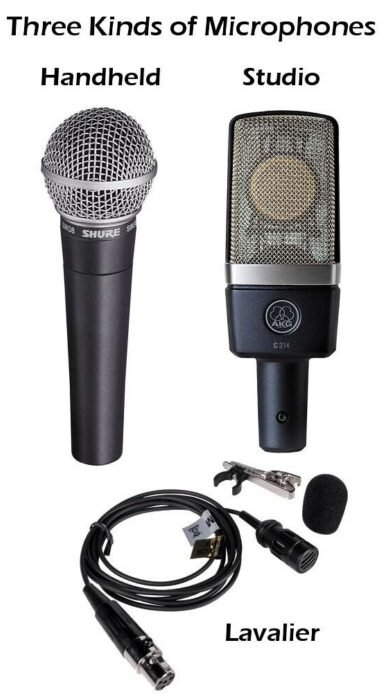
The Capsule - Sometimes called an Element, this part determines the transducer type of the microphone. The three most common types are dynamic, condenser, and ribbon. A capsule can be very small, such a lavalier or headset mic, medium sized, as with a handheld mic. or somewhat large, as with a Large-diameter condenser (LDC) mic. Four example types are shown to the right.
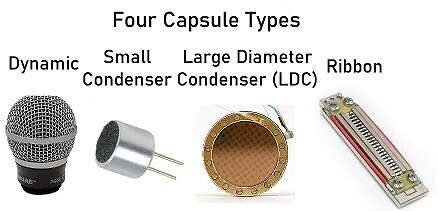
The Body - For a handheld mic. the body is designed to be held by the presenter. For a studio recording mic it is designed to be used with a a shock-absorbing clip or mount. The body may be plastic or metal and usually contains some type of noise-reduction components to support the capsule and may have electronic components inside. All handheld and studio mics incorporate some type of cover for the capsule to protect it from spittle and breath movements. Often this is just a metal mesh screen that is screwed onto the body. A typical handheld may have a thin layer of foam inside the cover. The headset mic shown to the right has a small foam pop filter over the tiny capsule.
The Cable - this part connects the capsule to the output connector. In some mics, it is just a cable, but in others it may include a transformer or a circuit board with numerous components. With a lavalier or headset mic, the cable is integral with the capsule. the body, and the output connector, which is usually designed to be connected to a wireless transmitter.
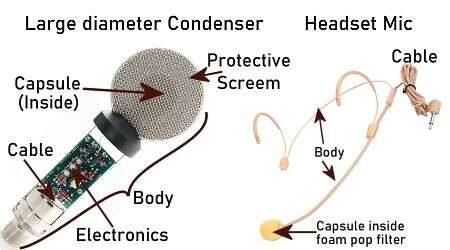
The Connector - This is the output part of a mic that delivers the signal to the amplification and control device.
That being said, we now have to understand that microphones can be wired or wireless, and this affects how the parts are configured.
Wired Microphones - Most wired mics have the four parts integrated into one solid piece. And for most of them, the connector is a 3-pin male XLR jack. By convention, the output connector is always male. This is intended to be used with a 2-wire shielded cable that is terminated with a female XLR plug*. The other end of the connecting cable is a male XLR plug intended to be connected to an amplification device that uses a balanced connection. By convention, all XLR inputs are female connectors. Two wires are used so that a Balanced Connection can be made, The cable can also carry a DC voltage called phantom power that some mics, such as a condenser mic, need to polarize the capsule and power its electronics, if present.
(* The term XLR stands for eXternal Line Return, first introduced by Cannon in the 1950s.)

Wireless Microphones - All wireless mics must contain or be connected to a transmitter, often called a body pack, that sends a radiofrequency signal to a receiver, which is then connected to the amplification device. With a handheld device, the transmitter components are inside the body, and the signal is radiated from a small antenna that is part of the body structure. Each transmitter operates at a selected frequency, and the receiver must receive only that frequency. Two reception antennae are used for professional mics to minimize what is called multi-path interference. The electronics of the receiver continuously scan and select the signal from the antenna that gives the strongest signal. For lavalier and headset mics, the capsule is connected to its output plug with a thin shielded multi-conductor cable that is then plugged into the transmitter. Different manufacturers use different styles of connectors, so an audio tech needs to be familiar with the various types.
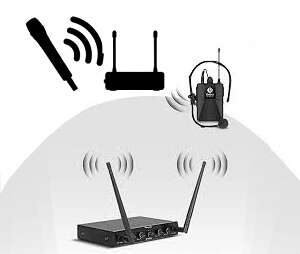
Beltpack Connector Types - There are four connector types commonly used plus 2 or 3 others that are less common. Usually, a bodypack or beltpack mic comes with only one connector, but Galaxy, Samson and MiCWL make headsets that come with four connector types. Most professional plugs have some type of locking mechanism to ensure they stay connected in use.
Shure - This is a 4- conductor female (TA4F) plug that has a locking projection that must be depressed to remove or insert the plug into the bodypack connector.
AKG - This is similar to the Shure but has only 3 conductors (TA3F). It too has a similar locking mechanism.
Audio Technica - This is a 4-=pin female plug with a locking sleeve mechanism that is easy to use.
Sennheiser - This is a mini (3.5. mm) TRRS plug with a screw-on sleeve. Typically, a TRRS plug is used to accommodate an earpiece as well as a microphone.
Other - Some semi-pro microphones will use a mini pug with or without a locking mechanism
Six Types of Bodypack Connectors
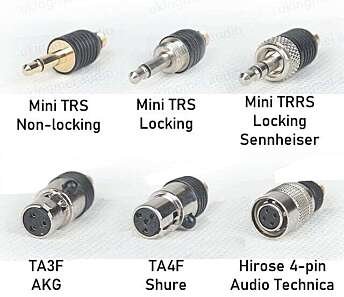
Thus it is important for an audio technician to understand the various types of microphones, how they are used, and the types of connectors used with them. When purchasing a lavalier or headset mic. its connector plug must match the transmitter with which it is to be used. It is critical when using bodypack mics, that the operator or user grasp the plug tightly and use its locking mechanism correctly when inserting or removing it so as not to put any stress on the cable itself.

